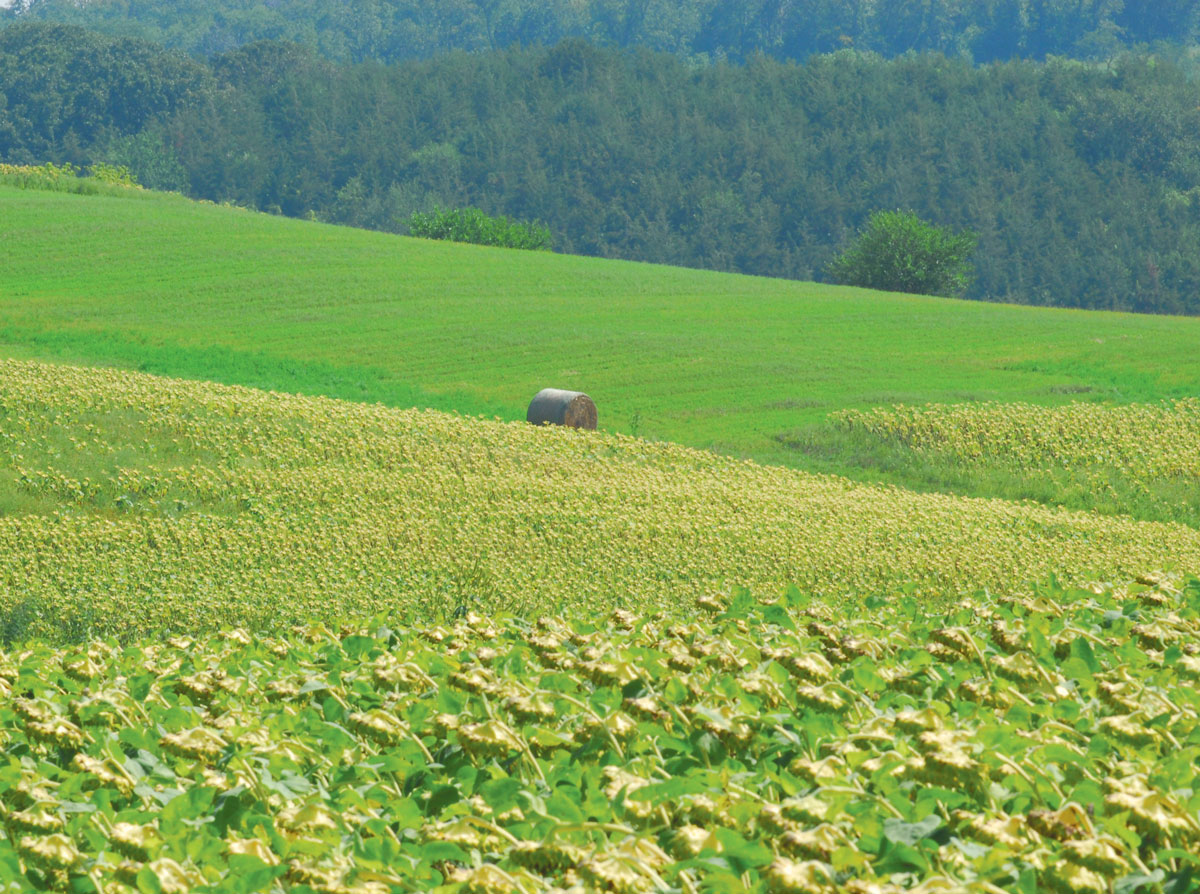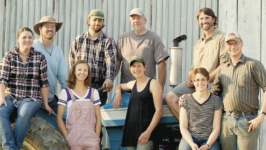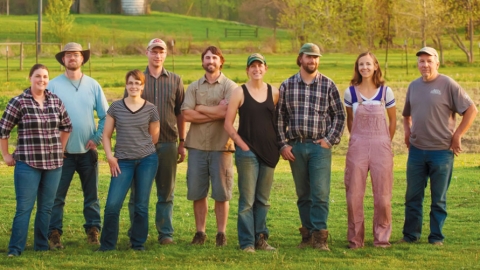Agriculture in Aggregate: Farmers Join Forces
Move over, middleman. These farmers are joining forces
“Everybody thought we were crazy,” says Jaime Moore of Wayward Seed Farm.
“But these aren’t just ideas we’re making up. They’re ideas that very smart people are implementing around the country.”
She’s talking about the driving concepts behind farmer-owner cooperatives—like Great River Organics (GRO), which she and seven other Central Ohio farmers joined forces to form last year.
The locavore movement has taken root across the country, with farmers markets sprouting by the thousands in cities and suburbs, where growers set up tents and tables, selling their corn and cucumbers, lettuce and lamb, directly to customers, one bag at a time. They’re a boon to eaters, who tuck into just-picked salad greens and heirloom peaches. And they’re famously good for farmers, who get to keep the customer’s dollar, rather than see the lion’s share go to brokers and middlemen.
But what about bigger farmers, and bigger buyers, who need to do transactions on a larger scale? The ones who need to work by the pallet, rather than the pint?
Enter the farmer-owned cooperative. In these groups, farmers join forces—by the handful or by the hundreds—to sell what they grow, in aggregate, into the wider marketplace, especially to larger wholesale buyers like supermarkets, restaurants, and food-service providers. Rather than go stand behind a table all day to sell small amounts to one eater at a time—or stay on the farm and hope a broker buys their crops at a decent price—farmers in a cooperative sell together to compete on a larger scale in a way they simply do couldn’t alone.
“Farmers often lack power in the marketplace and are at the mercy of the middlemen who set the prices. Cooperatives extend farmers’ reach into that value chain to help return more money to the farmer,” says John Cleary, New England Coordinator of Organic Valley. Headquartered in Wisconsin, the brand boasts nearly 1,900 member-farmers, making it the largest farmer-owned cooperative in the world.
“Companies have historically ripped off farmers by saying ‘here’s the price, take it or leave it’” explains John. “But this system lets farmer be price-setters, rather than price-takers. A corporation’s primary purpose is to generate money for their owners or shareholders—but in cooperatives, the shareholders are the farmers.”
That’s exactly what motivated Jaime and her fellow founding farmers at GRO. They’d watched for years as big businesses in the Columbus area were guided only by their bottom lines, shipping in produce from distant lands if it cost even a few percentage points less than the fruits and vegetables grown here in Ohio. Area supermarkets and restaurants are huge purchasers of produce, but it was hard to get her carrots in the door when systems are built for massive, international buyers. And to add insult to injury, as local became a buzzword, she saw plenty of mislabeling and misunderstanding.
“A lot of shoppers ultimately don’t know where the food is coming from. They go, ‘I shop at my local grocery store, so I’m buying local.’” But she says there “a big misconception” when big grocers sell millions of dollars of California produce but brag about spending a hundred dollars on some local cherries.
Not that big brands are inherently evil, but they typically buy from brokers who do what’s best for their own bottom lines, with no consideration for the family farmer or the Ohio economy. Sure, it’s understandable that Columbus supermarkets and restaurants like the convenience of ordering from one list, clicking through a site at 1am and having everything from lettuce to lemons arrive on a single truck the next day, rather than needing to liaise with a dozen different local farmers.
But Jaime says that mindset underestimates what local farms like hers can deliver. “They say ‘small farmers can’t support my needs, can’t keep up with my demand,’—but that’s not true, they just need to be clear about what that demand is.” Tell me what you want, in other words, and I’ll grow it. GRO, after all, now offers certified organic produce from 160 Ohio acres. That’s not small potatoes.
And cooperatives don’t just make transactions easier on the buyers—it’s also easier on the farmers. “It’s such a pain, selling to all these individuals,” says John. “Marketing is a huge job, and these cooperatives can take on that function for all the member farmers.”
And by pooling resources, each farm needn’t invest in its own infrastructure—such as a washing and packing line for produce, or a bottling plant for dairies. “By pooling resources, farmers can become more efficient,” says John. “It multiplies your power.”
Of course, cooperatives aren’t new; they’ve been around for more than a century. But John explains those were usually servicing generic commodity markets and as farms got bigger, commodity prices fell, dominated by big producers. Many of these older cooperatives lost their power in the ‘80s, victims of huge forces of consolidation and globalization. Like the rebirth of farmers markets (which of course were pretty much the only way anybody bought food throughout history, until a century ago), recent years have seen something of a rediscovery of the cooperative concept.
One leading example GRO looks to is Eastern Carolina Organics, which sells produce from more than 40 farmers to more than 100 accounts. While technically not a co-op—they’re an LLC—the brand is still a grower-owned distribution company. CEO and co-founder Sandi Kronick says, “We set ourselves up borrowing all the principles and values and operational system from the co-op concept. Because when farmers are invested in the company, they’re much more likely to preserve its long-term sustainability. We found it to be a very positive pressure. We’re not just another group knocking on farmers’ doors telling them we wanted to help them, and then go away in a few years.”
Like Jaime, she emphasizes that when farmers sell together, they’re much better positioned to fit larger systems.
“Grower-owned cooperatives can offer quality at the volume they need, as well as things like insurance and payment terms, but still represent transparency,” which is increasingly attractive to the end user (also known as an eater). If you’re a big buyer, continues Sandi, “you might need several pallets of cabbage, and still want to have a relationship with the farm. You can’t [easily] have a relationship with 40 farms, but you can make one call to the co-op, and have one cabbage delivery come in—from 40 local farms.”
You might say that the locavore movement is growing up—and Sandi sees these bigger buyers within that context. “It plays into wanting to know where the food comes from, the face behind their food,” she says. “A lot of research shows the greater level of trust people have when buying food from a farmer. Now we’re seeing the wholesale community—retailers, food service, and distributors—trying to be more transparent, and provide that face.”
And as John noted, Sandi knows when sales are streamlined, it’s easier on the farmer, too. “It’s hard, as a farmer, to do it all,” she says, citing everything from planting, irrigation, soil quality, weed management—you know, farming—and then they’re also supposed to handles sales, logistics, communications, and marketing?
“Most farmers do not want to do this middleentity service. It’s a huge burden!”
And when big buyers buy local, the results aren’t just good for the farm families selling their peaches and tomatoes. Area farms also employ more members of the community and deposit more money into the local bank, not to mention making decisions that take into consideration their own air quality and well water, rather than be tempted by a cost savings that will pollute the communities of distant strangers. Even the best-intended corporations can only care so much, when the bottom line is the bottom line.
That’s why, explains Sandi, “embedding these middle-entity services with not just a desire to help farmers, but institutionalizing by making them owned by farmers, is an enormously simple way to be sure you’re always caring about the farmer and not swayed by cheaper prices coming out of Mexico.”
All of which has enthusiasm as high as summer corn at GRO. Just one year in, they’ve expanded from their CSA and are selling to four area grocers, including Lucky’s Market, Green B.E.A.N. Delivery, and a super-supportive Whole Foods in Upper Arlington where the new buyer is, as Jaime puts it, “super excited.”
But Jaime’s not resting on those locavore laurels. “We’re showing what we as growers can do, proving ourselves,” she said. “We’re meeting a buyer today to talk about cabbage—they want 20,000 pounds. They want to make sure it’s a true commitment. And I say, ‘Hey, we can meet your needs, you just gotta tell us what they are.’”






